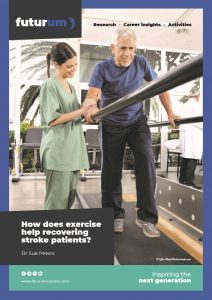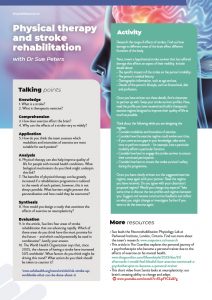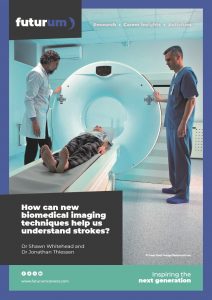How does exercise help recovering stroke patients?
The after-effects of a stroke can severely alter a person’s quality of life. Effects range from mobility issues to changes in brain function. However, the brain is surprisingly adaptable and often, with the right approaches, these lost functions can be partly or completely restored. At Western University in Canada, Dr Sue Peters is investigating the role of exercise in improving post-stroke recovery, and has found some promising results.
Glossary
Growth factor — a biological molecule that affects the growth and division of cells
Neuroimaging — producing images of the brain using bioimaging techniques
Neuroplasticity — the ability of the nervous system to reorganise parts of itself, especially following injury
Neurotransmitter — a chemical messenger secreted by a nerve cell that stimulates activity in another cell
Physical therapy — a healthcare profession that focuses on improving the body’s physical movements
Physiology — the field of biology that focuses on how the bodies of living organisms work
Rehabilitation — the process of returning to a good quality of life following a health issue
Stroke — a medical incident that happens when blood supply to part of the brain is disrupted, leading to damage to that part of the brain
Each year, millions of people around the world suffer from strokes. Depending on the level of damage, their brains may have the potential to recover, but only if the right support is in place. Studies are uncovering the surprising role that exercise plays in recovering from conditions such as strokes, as well as the intriguing links between physical activity and brain health. Dr Sue Peters of Western University is on the frontlines of growing this knowledge base. She is putting her findings into practice to help stroke survivors recover their health and quality of life.
What is a stroke?
Strokes happen when the blood supply to part of the brain is suddenly disrupted, either through a blood clot or a burst blood vessel. The brain cells downstream of this disruption become deprived of oxygen and nutrients, which causes them to become damaged or die.
Sometimes a stroke is fatal, but more often than not, the person will survive, albeit with potentially significant damage to brain tissue. “A stroke can affect many different areas of the brain,” explains Sue. The effects of strokes are diverse, and their impacts depend on which part of the brain is damaged. “Strokes can affect aspects of mobility such as coordination and spatial awareness,” says Sue. “This happens following damage to the brain’s sensory and motor regions, which disrupts the signals that control movement.” Even if stroke survivors show similar symptoms – weakness in a certain limb, for instance – it may be that different parts of the brain are damaged. “A stroke can cause weakness or paralysis on one side of the body, making everyday tasks such as balancing difficult,” says Sue.
How exercise affects the brain
We know that exercise is good for physical health: the more you exercise, the more physically fit you become. Less well-known is the fact that exercise can also benefit brain health. “When we engage in any physical activity, our muscles generate signals that travel to the brain,” explains Sue. “These signals trigger a cascade of physiological responses that may benefit cognitive health.” Examples of these responses include the release of certain neurotransmitters and growth factors. “Brain-derived neurotrophic factor, for instance, is a growth factor that can help to support the growth, maintenance and connectivity of brain cells,” says Sue. “This improves learning, memory and overall cognitive function.”
As well as triggering the release of these useful chemicals, physical exercise also increases blood flow to the brain. This means that brain cells receive more nutrients and oxygen, which allows them to function and develop better. “Physical exercise has been linked to structural changes in the brain, such as increases in grey matter volume in regions associated with memory,” says Sue. “This links to a concept called neuroplasticity.”
Neuroplasticity refers to the brain’s ability to change its structure and connections in response to its experiences. It is this ability that allows us to learn new skills, remember things and change our behaviour and habits. It is also a ray of hope for those who have suffered a stroke, as it provides the means by which the brain can repair and reorganise itself following damage.
Exercise as rehabilitation
Sue’s team are interested in understanding the effects of exercise on stroke patients’ brains and mobility, with the end goal of developing new therapeutic approaches for stroke recovery. “So far, we’ve found that those who exercise at a higher intensity during rehabilitation tend to have better cognition,” says Sue. Furthermore, the team found that exercise programmes tailored to an individual’s specific needs and abilities often led to big improvements in mobility, balance and overall physical performance. “We found that these rehabilitation programmes can have positive effects not only on physical function, but also on cognitive function and quality of life,” says Sue.
Reference
https://doi.org/10.33424/FUTURUM511
Tailoring such programmes to individuals’ needs is an important step. “Every stroke survivor is unique, with different strengths, challenges and goals,” explains Sue. “By assessing factors such as the severity of stroke, level of impairment, medical history and personal preferences, we can design personalised exercise programmes.” These programmes may employ different types of physical activity ranging from aerobic exercises, like walking or cycling, to strength training or balance exercises. “Each modality offers unique benefits,” says Sue. “Aerobic exercise can improve cardiovascular fitness, strength training can increase muscle strength, and balance exercises can enhance stability and coordination.”
Programmes also vary by intensity: higher-intensity exercise is typically associated with greater improvements, but it needs to be balanced by patients’ abilities and health. “We tend to recommend starting with moderate-intensity exercise, with intensity gradually increasing as the individual’s tolerance and fitness levels improve,” says Sue.
Next steps
The team are hopeful that soon they will be ready to take their findings from the lab to the clinic or rehabilitation hospital, which will mean reaching a larger range of stroke survivors that could potentially benefit from their work. “We would like to collaborate with healthcare providers to conduct clinical trials to evaluate the effectiveness of our exercise protocols and the effects they have on the body after a stroke,” says Sue. “Ultimately, we want to translate our findings into real-world clinical practice.”
The team also wants to develop their rehabilitation strategies to make them easily compatible with existing programmes for stroke survivors. “Through an innovative approach, we aim to improve mobility outcomes and quality of life for a wide range of individuals after a stroke,” says Sue.
 Dr Sue Peters, Assistant Professor, School of Physical Therapy, Faculty of Health Sciences, The Centre for Brain and Mind, Western University, Canada
Dr Sue Peters, Assistant Professor, School of Physical Therapy, Faculty of Health Sciences, The Centre for Brain and Mind, Western University, Canada
Researcher, Gray Centre for Mobility and Activity, Parkwood Institute, London, ON, Canada
Fields of research: Physical therapy, stroke rehabilitation
Research project: Investigating how exercise can help people recover from the effects of a stroke
Funders: Western University’s Interdisciplinary Development Initiative, Canadian Institutes of Health Research, Canadian Foundation for Innovation, Natural Sciences and Engineering Research Council of Canada, Ontario Research Fund
About physical therapy and stroke rehabilitation
Physical therapy is often a key part of helping people with diseases or conditions recover a high quality of life as part of an overall physiotherapy treatment plan. Studying and practicing exercise therapy and stroke rehabilitation involves a mixture of scientific knowledge and practical skills. Sue explains more about her field:
“Therapeutic exercise can benefit people with a wide range of diseases and conditions beyond strokes. This includes other neurological conditions like Parkinson’s disease, traumatic brain injury and spinal cord injury, as well as musculoskeletal conditions, cardiovascular disease and an array of mental health conditions. Therapeutic exercise is a powerful tool for improving quality of life and overall health outcomes across many diseases.”
There are several recent promising advances in stroke rehabilitation. These include:
- Robot-assisted rehabilitation: specialised robots that help support and improve movement in patients.
- Non-invasive brain stimulation: electrically stimulating areas of the brain to restore, or compensate for the loss of, affected functions.
- Virtual reality (VR) rehabilitation: using VR technologies to help improve a patient’s movements.
- Personalised rehabilitation approaches: rehabilitation techniques tailored to the unique needs and circumstances of individual patients.”
“Studying how exercise affects poststroke rehabilitation does have its challenges. But these can often be overcome with careful thought and innovation. One key challenge is that strokes can be highly variable in their location, severity and effects on individuals. This can complicate research efforts as the response to exercise can differ depending on these characteristics. To address this, we recruit diverse participant populations and conduct subgroup analyses, grouping together participants with similar stroke characteristics.”
“Encouraging adherence to exercise programmes can be difficult, particularly for individuals with transportation issues, cognitive impairments or lack of motivation. To overcome this, we employ strategies such as patient education, goal setting, social support and monitoring tools. We also have extended follow-up periods to understand the long-term effects of exercise, which requires ongoing communication and support to ensure continued participation.”
Pathway from school to physical therapy and stroke rehabilitation
In school, Sue recommends focusing on science and mathematics. Topics such as biology, anatomy, physiology and physics will provide valuable information. She adds that psychology and sociology are useful to understand human behaviour and social influences.
At college or university, Sue suggests pursuing a degree in fields such as neuroscience, kinesiology or exercise science. She recommends seeking out programmes with opportunities for hands-on experience through internships, clinical placements or research projects.
There are both academic and vocational routes into careers in stroke rehabilitation. Graduate programmes in neuroscience, rehabilitation science or physiotherapy may lead to opportunities in the field, while relevant vocational clinical training programmes include physiotherapy or occupational therapy.
Explore careers in physical therapy and stroke rehabilitation
Practical experience is vital. Seek out opportunities such as volunteering or shadowing in rehabilitation clinics, hospitals or research labs. Reach out to professionals near you working in the field to see if they can offer support or advice.
Sue recommends learning more via professional societies such as the Heart and Stroke Foundation (www.heartandstroke.ca/what-we-do/research/for-researchers), The World Stroke Organization (www.world-stroke.org) and the CanStroke recovery trials (canadianstroke.ca).
According to Glassdoor, the average salary for a physical therapist in Canada is about CAN $74k.
Meet Sue
Initially, I worked as a physiotherapist. This provided me with first-hand experience of the challenges that individuals face in recovering mobility after a stroke. This sparked my curiosity about the underlying neural mechanisms involved in mobility and how we can use these to enhance recovery. My interactions with patients motivated me to find ways to improve rehabilitation exercises.
By integrating neuroimaging techniques into my research, I have gained insights into the intricate connections between brain function and motor and sensory behaviours. This fusion of clinical experience and scientific inquiry has driven me to explore both basic neuroscience questions and clinical applications in neurorehabilitation.
My goal is to translate research findings into tangible improvements in mobility outcomes and overall quality of life. My work is not just about advancing scientific knowledge but also about making a meaningful impact on the lives of patients and their families.
It’s crucial to remain adaptable to new discoveries and insights. The fields of neuroscience and physiotherapy are evolving so quickly, so it’s important to accept that not all hypotheses will pan out as expected. It excites me that science is all about discovering why these unexpected results happen as a natural part of scientific inquiry and growth.
I’m proud of the advancements of my lab. We have built understanding of the neural mechanisms underlying mobility control, including discoveries made through neuroimaging techniques, like functional near-infrared spectroscopy and electroencephalography, which have shed light on how the brain adapts after stroke. I’m also proud of my graduate students in the Neurorehabilitation Physiology Lab and how our collaborative efforts have driven our understanding of how the brain controls our movements in the world.
In the long term, I want to scale up our efforts. By translating discoveries into practical applications for improving mobility rehabilitation practices through interdisciplinary collaborations and accelerating innovation through involving industry partners, we can improve neurorehabilitation for many people.
Sue’s top tips
1. Seek out diverse experiences to become a better scientist. This can include shadowing or volunteering, or even going to another country to learn about their healthcare system.
2. Focus on developing research skills like critical thinking and problem solving. Always stay curious and persistent.
Do you have a question for Sue?
Write it in the comments box below and Sue will get back to you. (Remember, researchers are very busy people, so you may have to wait a few days.)
Discover more about how new biomedical imaging techniques can help us better understand strokes:
www.futurumcareers.com/how-can-new-biomedical-imaging-techniques-help-us-understand-strokes












0 Comments